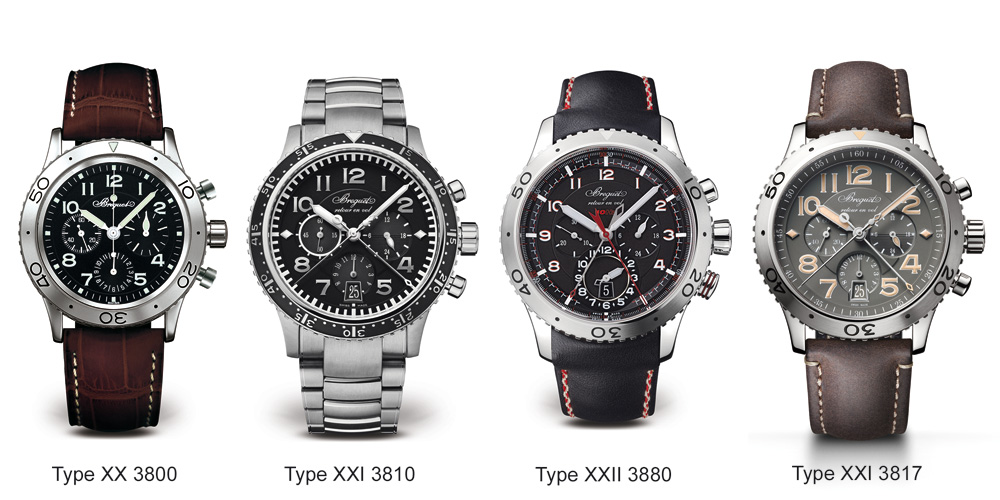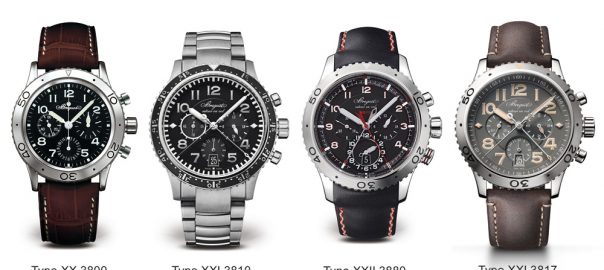The eponymous watch brand launched in Paris in 1775 by Abraham-Louis Breguet and run by the Brown family for a century ( 1870-1970 ) turned its attention to watches designed especially for pilots in the 1950s.
The first model of the steel chronograph designed for aeronautics was bought and tested by Louis Breguet in 1952 but it wasn’t until 1954 that the workshop bid on a tender from the War Ministry ( now the Ministry of Defence ) despite supplying the US Army since 1918 and the French aircraft manufacturer since 1922. The specifications were clear: the watch had to be easy to read, sturdy, easy to handle with a power reserve of at least 35 hours ; a real mechanical instrument with every pilot’s must-have flyback function worn on the wrist or screwed to the cockpit dashboard like in the 1920s. The watch was named Type XX in tribute to Louis Breguet’s aircrafts and approved by the French State. Over 2500 timepieces were provided mainly to the French Airforce who chose a model with a 30 minute counter whilst the French Naval Aviation department opted for one with an anti-magnetic internal container and 15 minute counter.
The Type XX couldn’t look more different to classic Breguet watches. It doesn’t have a pale engine-turned dial, hour rim with Breguet numerals or slim blue openwork “ pomme ” hands off-centre; its black dial features large Arabic numerals, two counters at 3 and 9 and wide luminescent hands. The indentation that adorned past Breguet designs reappeared on the Type XX’s bezel and the large crown. The notches gave the watch a masculine and military look.
The 38mm round steel case was unusually large for the time and its Valjoux 22 calibre (manual wind mechanical movement providing a 35-hour power reserve) had a flyback function. The flyback was one of the demands listed in the War Ministry’s specifications enabling wearers to reset and restart the chronograph. The resistance of the case and pushers was reviewed to ensure the watch could handle hundreds of manipulations with ease.

Breguet made the third generation of the Type XX almost 50 years later in 1995. The Type XX 3880 Aéronavale was true to the spirit of its forebear but with a contemporary design and technical features. The 39mm steel case had a rotating bezel bearing the minute scale and housed the self-winding Breguet 582 calibre with a chronograph and flyback function. The hour numerals and hands were coated in tritium (a radioactive material that’s now banned in watchmaking and usually replaced by Super-LumiNova) on the matt black dial whilst a chronograph hour counter joined the small seconds and minute counters.
Three versions of the Type XXI 3810 chronograph were unveiled at Baselworld 2011 : rose gold or titanium case with a chocolate dial and polished bezel or titanium case with a black dial. Its case had grown to 42mm and housed the self-winding Breguet 584Q/1 calibre which, on top of the signature Type XX functions, also fuelled the date, day/night indicator and 45-hour power reserve.
The Type XXII 3880 launched in 2010 to celebrate the 50th anniversary of the first Type XX delivery to the French Airforce and was a little more complex than the aforementioned models. Its self-winding Breguet 589F calibre featured cutting-edge watchmaking technology. Its high-frequency escapement (10 hertz, 72,000 beats per hour) had a Breguet balance wheel with timing screws, a spring, anchor and silicone escapement wheel. The flyback chronograph’s mechanical movement had a second time zone and date. Its notched 44mm case with a bidirectional rotating bezel came in steel ( black dial ) or rose gold (chocolate dial) on a leather or metal strap. The hours and minutes stood in the centre whilst a second time zone appeared at 6 finished off by the seconds at 9. The red varnished chronograph seconds hand tracked a 30-second scale split into white and red sections whilst the minutes ticked by in the centre.
By Sharmila Bertin breguet.com
